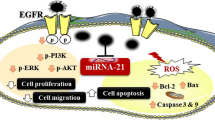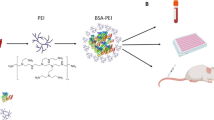Abstract
This study is to investigate the binding ability of Designed Ankyrin Repeat Proteins type Ec1that was fused to Low Molecular Weight Protamine (DARPin Ec1-LMWP) protein scaffold to the Epithelial Cell Adhesion Molecule (EpCAM) Cancer Stem Cell (CSC) marker and its efficiency in targeted delivery of small interfering RNA (siRNA) molecules into the studied cells. Gene fragment encoding the DARPIn Ec1-LMWP fusion protein was subcloned into pET28a expression vector following molecular docking studies performed to examine the affinity of the fusion protein towards EpCAM marker. The binding of the siRNA to the expressed fusion protein was tested through native PAGE. The toxicity of the fusion protein was tested by MTT assay. Attachment of the complex to the EpCAM marker was investigated by flow cytometry and delivery of siRNA into the cells was assessed by fluorescence microscopy. The expressed 21.6 kDa DARPin Ec1-LMWP fusion protein was purified and showed no cytotoxicity on tested cells. Arginine rich LMWP was efficiently bounded to the negatively charged siRNA molecule. Successful attachment of the fusion protein:siRNA complex to the EpCAM marker and its internalization into MCF-7 breast cancer cell line were confirmed. Here for the first time the recombinant DARPin Ec1-LMWP protein scaffold was designed and tested for targeting EpCAM surface marker and successful internalization of the siRNA into MCF-7 cells.






Similar content being viewed by others
References
Padma VV (2015) An overview of targeted cancer therapy. BioMedicine 5:1–6. https://doi.org/10.7603/s40681-015-0019-4
Baudino TA (2015) Targeted cancer therapy: the next generation of cancer treatment. Curr Drug Discov Technol 12:3–20. https://doi.org/10.2174/1570163812666150602144310
Eggel A, Buschor P, Baumann MJ et al (2011) Inhibition of ongoing allergic reactions using a novel anti-IgE DARPin-Fc fusion protein. Allergy 66:961–968. https://doi.org/10.1111/j.1398-9995.2011.02546.x
Hussain S, Plückthun A, Allen TM et al (2007) Antitumor activity of an epithelial cell adhesion molecule targeted nanovesicular drug delivery system. Mol Cancer Ther 6:3019–3027. https://doi.org/10.1158/1535-7163.MCT-07-0615
Winkler J, Martin-Killias P, Plückthun A et al (2009) EpCAM-targeted delivery of nanocomplexed siRNA to tumor cells with designed ankyrin repeat proteins. Mol Cancer Ther 8:2674–2683. https://doi.org/10.1158/1535-7163.MCT-09-0402
Boersma YL, Pluckthun A (2011) DARPins and other repeat protein scaffolds: advances in engineering and applications. Curr Opin Biotechnol 22:849–857. https://doi.org/10.1016/j.copbio.2011.06.004
Stahl A, Stumpp MT, Schlegel A et al (2013) Highly potent VEGF-A-antagonistic DARPins as anti-angiogenic agents for topical and intravitreal applications. Angiogenesis 16:101–111. https://doi.org/10.1007/s10456-012-9302-0
Hosse RJ, Rothe A, Power BE (2006) A new generation of protein display scaffolds for molecular recognition. Protein Sci 15:14–27. https://doi.org/10.1110/ps.051817606.10.1093/protein/gzp011
Weidle UH, Auer J, Brinkmann U et al (2013) The emerging role of new protein scaffold-based agents for treatment of cancer. Cancer Genomics Proteomics 10:155–168
Carter PJ (2011) Introduction to current and future protein therapeutics: a protein engineering perspective. Exp Cell Res 317:1261–1269. https://doi.org/10.1016/j.yexcr.2011.02.013
Stumpp MT, Amstutz P (2007) DARPins: a true alternative to antibodies. Curr Opin Drug Discov Devel 10:153–159
Stumpp MT, Binz HK, Amstutz P (2008) DARPins: a new generation of protein therapeutics. Drug Discov Today 13:695–701. https://doi.org/10.1016/j.drudis.2008.04.013
Gronwall C, Stahl S (2009) Engineered affinity proteins generation and applications. J Biotechnol 140:254–269. https://doi.org/10.1016/j.jbiotec.2009.01.014
Stefan N, Martin-Killias P, Wyss-Stoeckle S et al (2011) DARPins recognizing the tumor-associated antigen EpCAM selected by phage and ribosome display and engineered for multivalency. J Mol Biol 413:826–843. https://doi.org/10.1016/j.jmb.2011.09.016
Kim WT, Ryu CJ (2017) Cancer stem cell surface markers on normal stem cells. BMB Rep 50:285–298. https://doi.org/10.5483/bmbrep.2017.50.6.039
Abd El-Maqsoud NMR, Abd El-Rehim DM (2014) Clinicopathologic implications of EpCAM and Sox2 expression in breast cancer. Clin Breast Cancer 14:e1–9. https://doi.org/10.1016/j.clbc.2013.09.006
Bhindi R, Fahmy RG, Lowe HC et al (2007) Brothers in arms: DNA enzymes, short interfering RNA, and the emerging wave of small-molecule nucleic acid-based gene-silencing strategies. Am J Pathol 171:1079–1088. https://doi.org/10.2353/ajpath.2007.070120
Burnett JC, Rossi JJ (2012) RNA-based therapeutics: current progress and future prospects. Chem Biol 19:60–71. https://doi.org/10.1016/j.chembiol.2011.12.008
Jurk M, Vollmer J (2007) Therapeutic applications of synthetic CpG oligodeoxynucleotides as TLR9 agonists for immune modulation. BioDrugs 21:387–401. https://doi.org/10.2165/00063030-200721060-00006
Lorenzer C, Dirin M, Winkler AM et al (2015) Going beyond the liver: progress and challenges of targeted delivery of siRNA therapeutics. J Control Release 203:1–15. https://doi.org/10.1016/j.jconrel.2015.02.003
Choi YS, Lee JY, Suh JS et al (2010) The systemic delivery of siRNAs by a cell penetrating peptide, low molecular weight protamine. Biomaterials 31:1429–1443. https://doi.org/10.1016/j.biomaterials.2009.11.001
Tai W, Gao X (2017) Functional peptides for siRNA delivery. Adv Drug Deliv Rev 110–111:157–168. https://doi.org/10.1016/j.addr.2016.08.004
Li H, Tsui TY, Ma W (2015) Intracellular delivery of molecular cargo using cell-penetrating peptides and the combination strategies. Int J Mol Sci 16:19518–19536. https://doi.org/10.3390/ijms160819518
He H, Ye J, Liu E et al (2014) Low molecular weight protamine (LMWP): a nontoxic protamine substitute and an effective cell-penetrating peptide. J Control Release 193:63–73. https://doi.org/10.1016/j.jconrel.2014.05.056
Kole R, Krainer AR, Altman S (2012) RNA therapeutics: beyond RNA interference and antisense oligonucleotides. Nat Rev Drug Discov 11:125–140. https://doi.org/10.1038/nrd3625
Pärnaste L, Arukuusk P, Langel K et al (2017) The formation of nanoparticles between small interfering RNA and amphipathic cell-penetrating peptides. Mol Ther Nucleic Acids 7:1–10. https://doi.org/10.1016/j.omtn.2017.02.003
Bäumer S, Bäumer N, Appel N et al (2015) Antibody-mediated delivery of anti-KRAS-siRNA in vivo overcomes therapy resistance in colon cancer. Clin Cancer Res 21:1383–1394. https://doi.org/10.1158/1078-0432.CCR-13-2017
Yoo H, Mok H (2015) Evaluation of multimeric siRNA conjugates for efficient protamine-based delivery into breast cancer cells. Arch Pharm Res 38:129–136. https://doi.org/10.1007/s12272-014-0359-8
Zhang C, Ren W, Liu Q et al (2019) Transportan-derived cell-penetrating peptide delivers siRNA to inhibit replication of influenza virus in vivo. Drug Des Devel Ther 13:1059–1068. https://doi.org/10.2147/DDDT.S195481
Liu M, Feng B, Shi Y et al (2015) Protamine nanoparticles for improving shRNA-mediated anti-cancer effects. Nanoscale Res Lett 10:134. https://doi.org/10.1186/s11671-015-0845-z
Chang LC, Lee HF, Yang Z et al (2001) Low molecular weight protamine (LMWP) as nontoxic heparin/low molecular weight heparin antidote (I): preparation and characterization. AAPS PharmSci 3:E17. https://doi.org/10.1208/ps030317
Shukla RS, Qin B, Cheng K (2014) Peptides used in the delivery of small noncoding RNA. Mol Pharm 11:3395–3408. https://doi.org/10.1021/mp500426r
Ye J, Liu E, Gong J et al (2017) High-yield synthesis of monomeric LMWP(CPP)-siRNA covalent conjugate for effective cytosolic delivery of siRNA. Theranostics 7:2495–2508. https://doi.org/10.7150/thno.19863
Boersma YL (2018) Advances in the application of designed ankyrin repeat proteins (DARPins) as research tools and protein therapeutics. Methods Mol Biol 1798:307–327. https://doi.org/10.1007/978-1-4939-7893-9-23
Milovnik P, Ferrari D, Sarkar CA et al (2009) Selection and characterization of DARPins specific for the neurotensin receptor 1. Protein Eng Des Sel 22:357–366
Liang JF, Zhen L, Chang LC, Yang VC (2003) A less toxic heparin antagonist—low molecular weight protamine. Biochemistry (Moscow) 68:116–120
Arabzadeh S, Tehranizadeh ZA, Haghighi HM et al (2019) Design, synthesis, and in vitro evaluation of low molecular weight protamine (LMWP)-based amphiphilic conjugates as gene delivery carriers. AAPS PharmSciTech. https://doi.org/10.1208/s12249-018-1235-5
Sokolova EA, Shilova ON, Kiseleva DV et al (2019) HER2-specific targeted toxin DARPin-LoPE: immunogenicity and antitumor effect on intraperitoneal ovarian cancer xenograft model. Int J Mol Sci 20:2399. https://doi.org/10.3390/ijms20102399
Shilova ON, Deyev SM (2019) Promising scaffolds for theranostics. Acta Nat 11:4–43
Acknowledgements
The authors wish to express their deep gratitude to all who provided technical supports. This project was financially supported by Pasteur Institute of Iran.
Author information
Authors and Affiliations
Contributions
YT and MK were chief investigators. FD and MK and FM contributed to the design of the study. HS assisted in Molecular docking analysis. NB was responsible for the major experimental work and contributed in writing the main manuscript. FB and EB assisted in data collection. YT, MK and FD contributed revising the main manuscript.
Corresponding authors
Ethics declarations
Conflict of interest
The authors have no conflicts of interest to declare.
Ethical approval
This article does not contain any studies with animals performed by any of the authors.
Additional information
Publisher's Note
Springer Nature remains neutral with regard to jurisdictional claims in published maps and institutional affiliations.
Electronic supplementary material
Below is the link to the electronic supplementary material.
Rights and permissions
About this article
Cite this article
Babaee, N., Talebkhan Garoosi, Y., Karimipoor, M. et al. DARPin Ec1-LMWP protein scaffold in targeted delivery of siRNA molecules through EpCAM cancer stem cell marker. Mol Biol Rep 47, 7323–7331 (2020). https://doi.org/10.1007/s11033-020-05752-5
Received:
Accepted:
Published:
Issue Date:
DOI: https://doi.org/10.1007/s11033-020-05752-5




